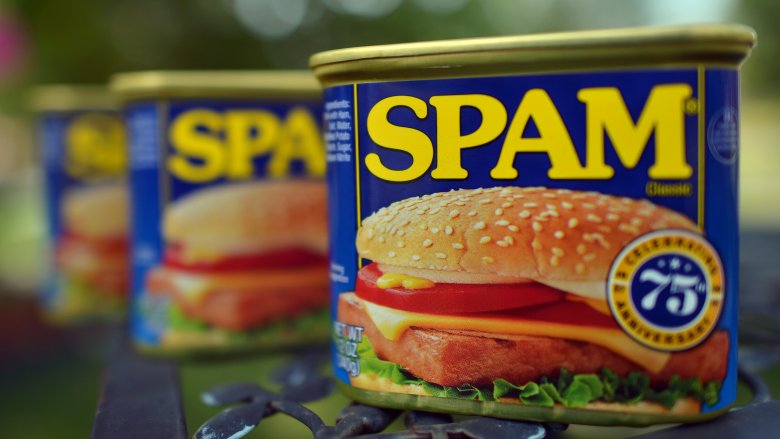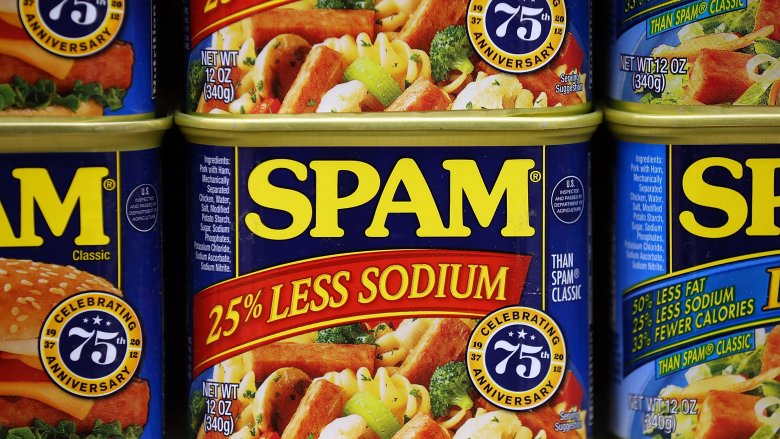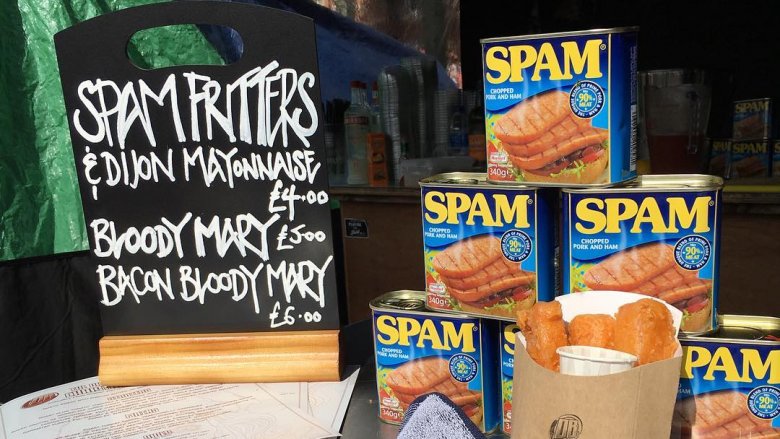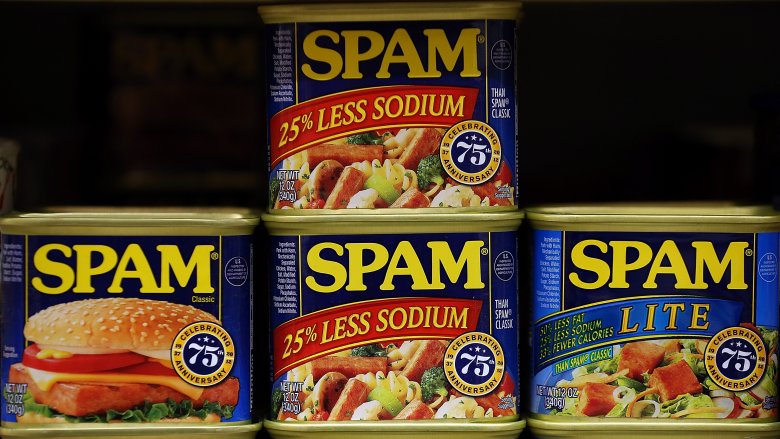The Untold Truth Of Spam
Spam (we're talking chopped pork and ham here, not the unwanted email): Monty Python made it a pop culture phenomenon. Hawaiians adore it. Gordon Ramsay (unsurprisingly) loathes it. The people of Guam eat an average of 16 cans per year. South Koreans consider it a luxury item. There isn't a whole lot of middle ground when it comes to the infamous and iconic canned food — you love it or you hate it. But either way, you probably haven't spent a whole lot of time getting to know the "versatile" meat, as it's been dubbed by the brand.
Turns out there's a lot about Spam you probably don't know, like the fact that it's made with surprisingly few ingredients, or that it played a big role in World War II. How about the fact that London's Big Ben is 1,163 Spam cans tall? Read on for more fun tidbits you never knew you needed to know.
The name is a mystery
There are plenty of guesses to what Spam actually stands for: Something Posing As Meat. Specially Processed American Meat. Slimy Processed Anemic Mucus. But what's the real answer?
According to the brand's website, we may never know. "The significance of the Spam brand name has long been a subject of speculation. One popular belief says it's derived from the words 'spiced ham.' The real answer is known by only a small circle of former Hormel Foods executives. And probably Nostradamus."
We do know that Hormel Foods has previously stated that it stands for "Shoulder of Pork And Ham," which makes perfect sense, but they don't cop to that today. We also know that Ken Daigneau, the brother of a Hormel vice president, is responsible for naming the product. According to Neatorama, Jay Hormel threw a party and told guests they'd each get a free drink if they wrote down a potential name for the new canned meat. The story goes that Daigneau blurted out "Spam!" at some point during the night, and the rest is history.
It has surprisingly few ingredients
Spam is sometimes regarded as a bit of a mystery meat, but it turns out that it's not such a big mystery after all. In fact, original Spam has only six ingredients:
- Pork with ham, which their website lists as one ingredient, and since ham is technically pork, we'll give them a pass here.
- Salt. Anyone who has ever eaten Spam is not surprised that this is the number two ingredient.
- Water.
- Potato starch, which keeps the meat moist.
- Sugar. Spam is sure to note that they use "the real deal, not that fake syrup found in other foods."
- Sodium nitrate. A common preservative found in processed meats.
Not too shabby for canned meat with a long shelf life, right? But don't get too excited. Although it's not chock full of chemicals and hard-to-pronounce ingredients, Spam isn't exactly a health food. One two-ounce portion contains 16 grams of fat, 6 grams of saturated fat, and 790 milligrams of sodium (33 percent of your daily recommended intake), and let's be honest — you're probably going to eat more than two ounces. Bottom line? Spam all day every day probably isn't the best idea.
Or maybe you can eat it every day
Then again, maybe a diet that includes a daily dose of Spam isn't so bad after all.
Wales Online reports that Chris Stephens has eaten the canned meat every day for nearly 60 years. He even travels with his own supply, and Hormel Foods has named him the Welsh "Spambassador" for his dedication to the product. "It's such an iconic brand and I've grown up eating Spam every day since a very early age. I love the unique flavor and would eat multiple cans a day but my wife has put me on a diet recently so I've cut down to one tub per day," Stephens says. "My wife thinks I'm crazy and my love of Spam drives her crazy but she understands it's an essential part of my daily diet. I love it and couldn't imagine traveling abroad without a few tubs of the trusty stuff coming along with me."
Just to recap: One tub per day equals 96 grams of fat, 36 grams of saturated fat, and a whopping 4,740 grams of sodium. Best of luck to you, Chris.
Gordon Ramsay (really) hates it
The always-opinionated Gordon Ramsay doesn't seem to live by the rule "if you don't have anything nice to say, don't say anything at all," and unsurprisingly, he didn't have anything nice to say about Spam. Of course, that didn't stop him from saying it.
On an episode of the now-cancelled British television series, Hotel GB, Ramsay recalled a dish from his childhood, saying that his dislike for the canned meat is what led him to the kitchen. "Sliced, disgusting f**king Spam. Did you grow up with that stuff? I did. I had Spam every Friday night. I decided to cook for a living to stop eating so much s**t," he said. "I didn't have a choice. It wasn't about what I didn't like. It was what we got fed. Spam like a brick. Spam straight out of a can every Friday night. Spam egg and chips. Done."
To be fair, Spam straight out of the can probably isn't the most appetizing way to eat it. A little frying goes a long way...
Someone made a Spam cocktail
So maybe a thick slab of processed meat isn't your thing. Maybe you're more of a processed meat cocktail kind of person? If so, you're in luck, because someone made a Spam cocktail, and yes, it really does contain Spam. Yum?
Chicago's Duck Inn created the SpaMai Tai, presumably to see how just how far they could push the envelope with drunk bar-goers, and it even comes served in the classic Spam can. The cocktail starts off like a regular ol' mai tai, but things get a little dicey when it comes to the Spam-infused dark rum. The process involves baking Spam covered in lard, then using the infused fat to flavor the rum. There's a lot of straining involved, so you're not likely to get a chunk of Spam — just that salty processed meat flavor. And good news — If you aren't near Chicago but don't think you can go another day without tasting a SpaMai Tai, you can always try making it at home.
How it's made might surprise you
Pop the top off a can of Spam and you might wonder how they get that perfectly formed brick inside. But it's not molded and then carefully placed inside after the meat is cooked — it's actually cooked in the can.
Because the Spam-making process is highly automated, it takes only 13 workers to oversee the entire operation. Here's how it's done: The pork and ham is received by the plant and after processing the meat it gets ground into 8,000 pound batches. The ground meat is combined with the other five ingredients and mixed for 20 minutes to reach a desired temperature. That mixture is then pumped into the iconic blue cans which are sealed shut and moved into a cooker that is six stories tall and holds an astounding 66,000 units at one time. Finally, the cans are heated to a temperature which cooks the meat and kills any bacteria before being cooled, cleaned, and labeled. The result is an astonishing output of 350 cans of Spam produced a minute. Mind. Blown.
It helped win the war
In 1941, with World War II in full swing, Hormel pitched in to the effort and shipped more than 100 million cans abroad to feed American GIs and Allied troops — a no-brainer considering the canned meat didn't need refrigeration and had a long shelf life.
While it's said that Spam helped win the war, the processed meat also became the food everyone loved to hate. Former Soviet Premier Nikita Khrushchev wrote in his memoir, "There were many jokes going around in the army, some of them off-color, about American Spam; it tasted good, nonetheless. Without Spam, we wouldn't have been able to feed our army. We had lost our most fertile lands."
After the war, Dwight D. Eisenhower wrote to a Hormel executive, "I ate my share of Spam along with millions of other soldiers. I'll even confess to a few unkind remarks about it — uttered during the strain of battle, you understand. But as former Commander in Chief, I believe I can still forgive you your only sin: Sending us so much of it."
High praise for such a loathed product.
Spam by the numbers
If you're a Spam hater, you probably find it hard to imagine eating a single bite of the processed meat, let alone a whole can of the stuff. But Spam lovers are apparently working overtime — 12.8 cans of Spam are eaten every second. Yes, you read that right — every second. Some quick math tells us that we're collectively gobbling up almost 800 cans per minute, over 1 million cans a day, and over 400 million cans a year. Maybe there aren't too many haters out there after all.
Over 8 billion cans of Spam have been sold since it's introduction in 1937, with 15 varieties sold in 44 countries around the world. Two locales lead the way in Spam consumption though — Guam and Hawaii. The average consumption in Guam is 16 cans per year (per person), and Hawaiians consume a mind boggling 7 million cans a year as a whole. But more on that love affair momentarily...
It might have saved Hawaii
Visitors to the Hawaiian islands will notice a common thread on the local menus very quickly: Spam, Spam, and more Spam. It's turned into sushi, it's added to fried rice, it's eaten with eggs, and it's even served at McDonald's. So how did Spam become the unofficial national dish of Hawaii?
It turns out the canned meat actually saved the day for potentially hungry Hawaiians. Food historian Rachel Laudan told Eater that after World War II, the U.S. government placed restrictions on Hawaii's deep-sea fishing industry, which was largely made up of Japanese-Americans. "Unlike the mainland, they couldn't intern all the Japanese [in Hawaii]. The economy would have collapsed," Laudan says. "Because islanders were no longer allowed to fish, one of the important sources of protein for the islands vanished." Enter Spam, glorious Spam. It fed the people of Hawaii while those sanctions were in place, and never left their kitchens. According to Laudan, Spam also saved the day in Korea and Japan, both of which she says "were on the point of starvation. The cans of Spam coming in were an absolute godsend in those terrible situations at the end of World War II."
Proof that Hawaiians still embrace the canned meat after all these years? To this day they proudly consume more Spam per person than any other state in the U.S.
The Monty Python effect
The notorious Monty Python sketch not only turned the canned meat into a pop culture phenomenon — it also led to the coining of the term "spam" in reference to unwanted email.
According the The Register, Hormel Food's website once read: "Use of the term 'SPAM' was adopted as a result of the Monty Python skit in which a group of Vikings sang a chorus of 'SPAM, SPAM, SPAM...' in an increasing crescendo, drowning out other conversation. Hence, the analogy applied because UCE (unsolicited commercial email) was drowning out normal discourse on the internet. We do not object to use of this slang term to describe UCE, although we do object to the use of our product image in association with that term."
Hormel apparently changed its mind though when they saw an opportunity for a profitable partnership. With the debut of the Broadway musical Spamalot, they embraced the Monty Python effect and released a special edition can for the occasion. "Spam products have been spoofed by the Monty Python comedy team for decades," said Nick Meyer, senior product manager, Hormel Foods. "The brand is beloved by many, so we are pleased to offer this special collector's edition can and Spam golden honey grail to consumers."










